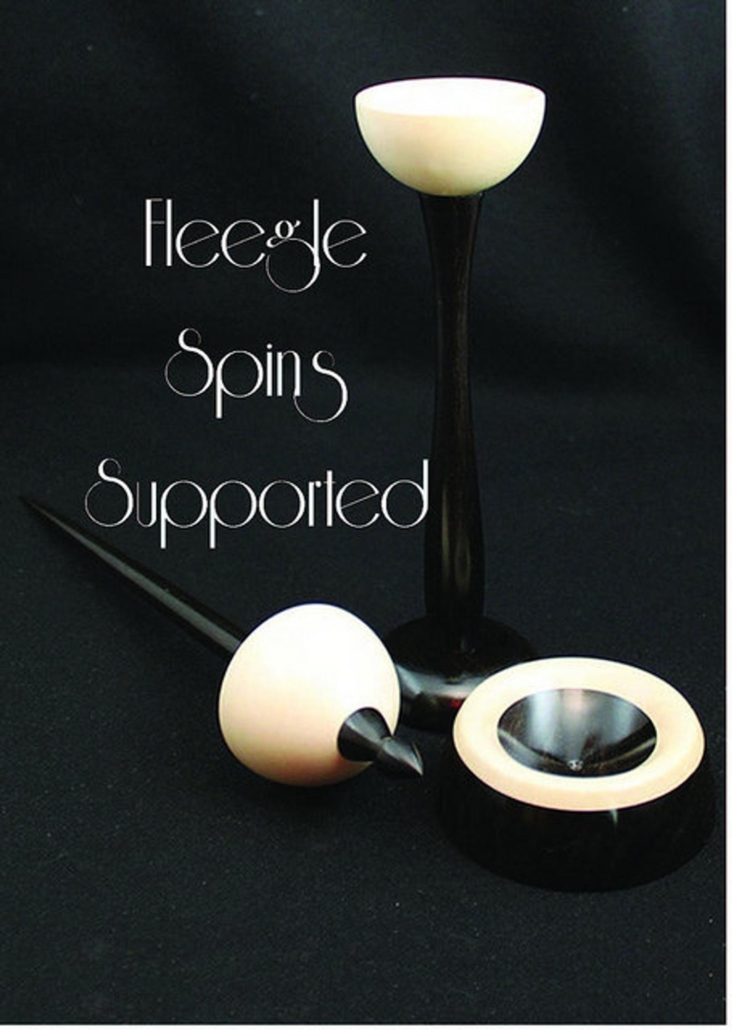Book Review: Fleegle Spins Supported by Susan Glinert Stevens
reviewed by Sukrita Mahon

Perhaps because of the rise of the internet and social media, spinning is enjoying a revival – possibly its second one in the post-industrial era, the first having taken place in the 1960s–70s or so. In a lot of ways, though, it remains a niche interest, with quirks that even those within the community struggle to explain. One such quirk is demonstrated in the highly unusual format of this “book”: it’s a USB drive shipped manually, containing an interactive PDF and videos. I’m just as baffled as you probably are. Why not make the files available for download?
This “book” was published in 2012, and I wonder if this was an attempt on the author’s part to bypass both conventional publishing routes as well as the personal expense of self-publishing. I do wish they had an alternative method of distribution and still hold out hope of an upgrade one day.
The buy-the-USB format means the book is highly inconvenient and expensive to purchase outside the U.S. or Americas. I had purchased my copy in Australia through the spindle maker Malcolm Fielding, as part of a “learn to spin on supported spindles” set. This offering is no longer available since the maker has retired and passed on the business to their successor. If I had to purchase it from the U.S. today, the price combined with shipping would be a serious deterrent.
That said, if you can get over the feeling of confusion of buying a “USB book,” the material it contains is excellent. Trying to learn support spindle spinning can be a very frustrating experience. There seems to be almost no literature on the subject (barring a few magazine issues), videos online feel incomplete and lacking enough description, and local guilds may or may not have the required knowledge. Fleegle, aka Susan, provides all the technical information for the beginner to start spinning supported.
There are many reasons to learn support spindle spinning: it’s the only way I find it possible to spin cotton, for instance. It can be a much more accessible way of learning to spin long draw, as it feels a lot more intuitive than on a wheel. I often hear that support spinning may be more comfortable for long stretches of time compared to using a drop spindle, but I’m awkward enough that either can result in pinched nerves. For those who prefer spinning seated, or who have mobility issues, it may be worth looking into as an option.
The book contains an interactive PDF and a printable PDF, along with 25-odd videos. It is photo-heavy and humorously written, briefly referencing the Ravelry forums, where the idea for the book originated – Fleegle is the author’s Ravelry name. This may or may not be appealing to readers, depending on how they relate to the “forum era” of the internet. I have to admit that there’s a portion about a hairy frog that I’m still puzzled about but don’t care enough to try to understand.
The section on fiber is very extensive: it covers dog and cat hair, possum, cow and horse hair, deer hair, pig fur… the list is endless and fascinating. I learned a lot from it, despite the fact that almost every spinning book has a fiber chapter. The author takes full advantage of the fact that we have unprecedented access to novel fibers today, and the idea that we are only limited by our imaginations is very freeing. The experimental portions, such as spinning straw, are interspersed with practical information, such as how to handle various preparations of silk.
For those looking to use plant-based fibers, there is a section on flax, ramie, nettle, milkweed, fireweed, pineapple, and even kozo or mulberry paper. The author correctly calls out the polluting processing methods of increasingly popular fibers, such as bamboo, soy, banana, and milk, that are promoted as plant-based despite being unsustainable. There is even a section on spinning with feathers.
Fleegle goes on to explore color and working with different fiber preparations for support spindles: from processing and working with raw fleece to using dyed tops and blended batts. It is quite in-depth but still interesting for intermediate-level spinners. The ever-relevant question of how to avoid colors blending into “mud” as they are spun is addressed. There are tutorials on making fauxlags and pseudo-rolags, which are very useful for long draw.
There’s a chapter called Support Spindles Around the World, which explores the various spindle styles and traditions that exist worldwide. The diversity in form and spinning style in each tradition is very intriguing. This chapter ends with a portion on bead style spindles, which I have yet to use. However, there is an instructional chapter on how to make your own bead spindle, with photographs. The book mentions another spindle I have yet to see in the wild – a lap spindle with built-in support. These are available online from makers such as Spindolyn.
It’s easy to get overwhelmed when trying to decide on a spindle to buy, although it gets easier with practice. The section on the anatomy of a support spindle and what to look for is extremely useful. Many of their favorite makers are listed here, which is helpful despite the fact that such a list could never be conclusive. The author has gone above and beyond in giving us readers all the information we may need: even to the extent of showing step-by-step photos of how support spindles are made.
The spinning how-tos are meticulously presented, with every technique both written out and demonstrated on video. Special care is taken to show both left- and right-handed technique. Among the tutorials are park and draft, long draw, and semi-continuous spinning. Fleegle spins with an ease that is so graceful and enviable; it makes you want to be that good, too. They go on to explain how to make a cop, whether to choose to make a temporary cop or a permanent one, and what the difference is. Despite the detail, the reader is encouraged to try everything and break the rules.
Plying on a support spindle is examined in some depth, even though it’s a little impractical. We are walked through troubleshooting steps while winding off onto plying balls, which is much appreciated. In case you were looking for a real challenge, there is a how-to on chain plying on a support spindle. Personally, I don’t think I’m going to try that anytime soon, but it’s good to know it’s possible.
The book ends with a section on spinning bowls, which is amusing since the novice support spinner may not yet know that bowl collecting is about to be a significant part of their new interest.
All in all, Fleegle Spins Supported is a fantastic resource for the beginning support spindler, particularly one who feels disheartened with most available tutorials. It’s just a shame about the USB format.
Rating: 3.5/5
PLY Magazine believes that Black lives matter, as well as LBGTQI+ lives. Those most vulnerable and persecuted in our communities deserve our love and support. Please be good to each other.





Thanks for the review and the reminder of this resource. I too bought this as part of a learn to spin kit from Malcom Fielding. I am forever misplacing the usb (it doesn’t exactly fit easily on the shelf next to other spinning books) but this is the summer/fall I have resolved to learn to better use my support spindles. I think it is time to find it again and maybe even print out the pdf. Certainly there is so much material on the usb that I have only scratched the surface in reading it.
If the USB book is not feasible or too fiddly, I learned the basics of supported spindle spinning on a tahkli. They are basically a tiny supported spindle. Joan Ruane is a well-known plant fiber spinner and teacher who has some online resources for tahkli spinning. There are differences obviously between drafting plant fibers and animal fibers but those differences can be understood through other reasoning. The tahkli material gives a pretty good overview of how to spin and handle the spindle, which to me is the most difficulty part of learning the supported spindle.